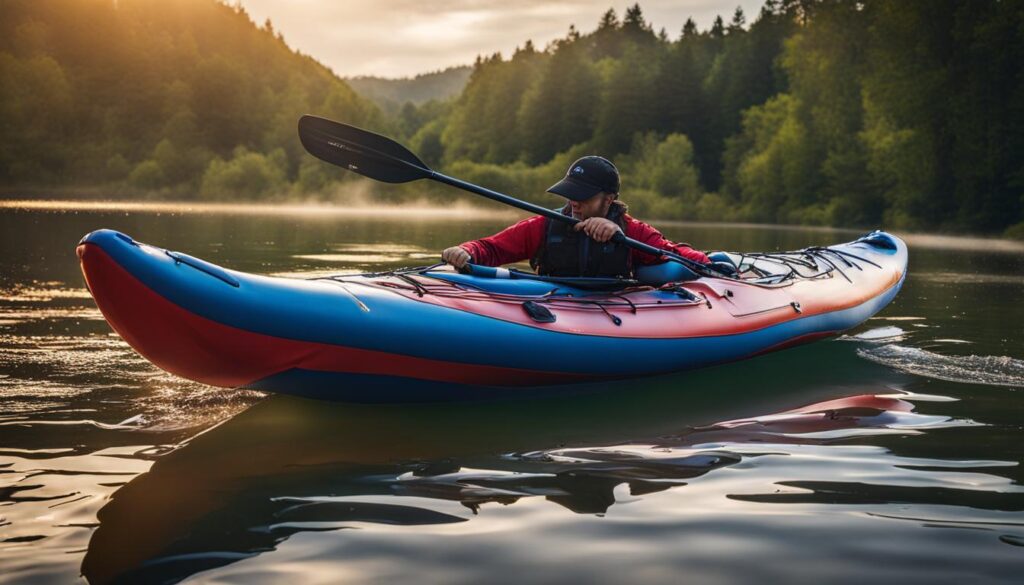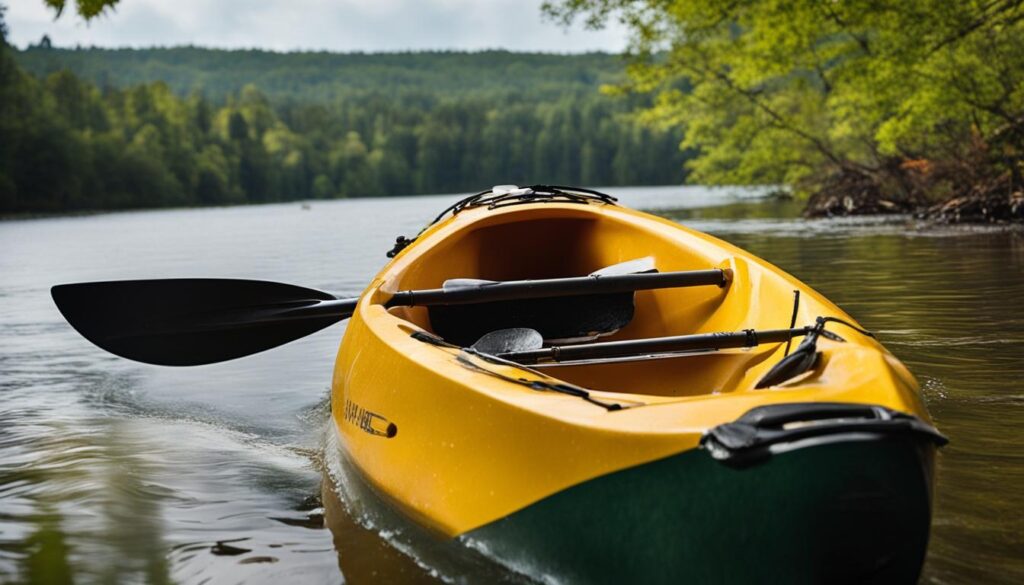Staying dry is essential when enjoying your kayaking adventures. Proper drainage and drying techniques can help prevent water damage and prolong the lifespan of your kayak. In this section, we will explore effective methods for draining and drying your kayak after use.
After a thrilling paddle, it’s important to remove any water that has entered your kayak. This will not only prevent damage to the internal components but also ensure a comfortable and safe experience on your next outing. Let’s dive into some kayak draining techniques and tips for effective water removal:
Key Takeaways:
- Utilize scupper plugs and drip rings to minimize water entering your kayak.
- Raise your seat and wear waterproof clothing to stay dry during your paddle.
- Use a bilge pump or sponge to remove any water that accumulates in the kayak.
- Avoid rough water conditions to minimize the risk of water entering your kayak.
- Be prepared for colder conditions by carrying dry clothes and an emergency kit.
By following these drainage and drying techniques, you can ensure a dry and enjoyable kayaking experience while preventing water damage to your kayak. Stay tuned for the next section, where we’ll explore tips for drying inflatable kayaks.
Tips for Drying an Inflatable Kayak
Inflatable kayaks are a popular choice among kayakers due to their portability and ease of storage. However, properly drying an inflatable kayak after use is crucial to prevent mold and mildew buildup. Here are some effective kayak drying methods and quick solutions to help you maintain your inflatable kayak:
1. Sun Drying
One of the easiest methods to dry an inflatable kayak is to leave it in the sun for a short while. The heat from the sun will help evaporate the moisture on the surface of the kayak. However, it’s important to note that prolonged exposure to the sun’s UV rays can cause damage to the kayak material, so it’s best to limit the drying time to a couple of hours.
2. Towel Drying
If you’re short on time or don’t have access to direct sunlight, you can use towels to dry the outer surfaces of the kayak. Wipe down the kayak thoroughly, paying special attention to the areas where water tends to accumulate, such as the cockpit and the seat. Additionally, use the towels to absorb any water that may have entered the kayak.
3. Draining and Wiping
To remove excess water from the inside of the inflatable kayak, start by deflating the floor. This will allow any trapped water to drain out. Tip the kayak to different angles to ensure all water is expelled. Once the majority of the water is drained, use towels to wipe down the interior of the kayak, absorbing any remaining moisture.
| Drying Method | Advantages | Disadvantages |
|---|---|---|
| Sun Drying | Free and natural method | Prolonged exposure can cause damage to the kayak |
| Towel Drying | Quick and easy | May not be as effective for removing all moisture |
| Draining and Wiping | Effective for removing excess water | Requires more effort and time |
Remember, it’s important to ensure that the kayak is completely dry before storing it. Any leftover moisture can lead to mold and mildew growth. By following these effective drying methods, you can maintain the quality of your inflatable kayak and prolong its lifespan.

References:
- [Reference 1] – “Drying Your Inflatable Kayak – How to Avoid Mold and Mildew”
- [Reference 2] – “Proper Care and Maintenance for Your Inflatable Kayak”
- [Reference 3] – “Tips for Drying an Inflatable Kayak”
Kayak Hull Drying Tips in Cold Weather
When engaging in kayaking adventures during cold weather, it’s essential to take preventive measures to avoid the risk of hypothermia. In addition to wearing appropriate waterproof clothing and using scupper plugs to prevent water from entering the kayak, ensuring proper kayak hull drying is crucial for your safety and the longevity of your kayak.
To effectively dry the hull of your kayak in cold weather, consider the following tips:
- Use a kayak drying rack: Investing in a kayak drying rack can help elevate your kayak off the ground, allowing air to circulate freely around the hull. This promotes quicker air drying and prevents moisture buildup, reducing the risk of mold and mildew.
- Utilize air drying techniques: After a kayaking session, remove any excess water from the kayak by using a bilge pump or sponge. Then, prop the kayak upright with the cockpit facing down to allow any remaining water to drain out naturally.
- Thoroughly wipe down the kayak: Once the excess water has drained, use a towel to wipe down the interior and exterior of the kayak. Pay special attention to areas prone to water accumulation, such as the seat area and footwells, to ensure complete drying.
- Store the kayak properly: Before storing your kayak, ensure it is completely dry. Storing a damp kayak can lead to mold and mildew growth. Choose a well-ventilated, dry storage area to prevent moisture accumulation and potential damage to your kayak.
By following these kayak hull drying tips, you can maintain the integrity of your kayak and enjoy safe and comfortable paddling experiences even in cold weather conditions.
| Drying Tip | Benefits |
|---|---|
| Using a kayak drying rack | Promotes quicker air drying, reduces risk of mold and mildew |
| Utilizing air drying techniques | Allows for natural water drainage, eliminates excess moisture |
| Thoroughly wiping down the kayak | Ensures complete drying, reduces risk of mold and mildew |
| Properly storing the kayak | Prevents moisture accumulation and potential damage |
Remember, keeping your kayak dry and well-maintained is not only crucial for your comfort but also for the longevity of your investment. Incorporate these kayak hull drying tips into your routine to ensure many more enjoyable kayaking adventures.
Quote:
The proper drying of your kayak hull is essential to prevent mold, mildew, and potential damage. By following these tips, you can ensure that your kayak stays in great condition and ready for your next cold-weather paddling excursion.

Conclusion
In conclusion, maintaining the dryness of your kayak is vital to safeguard its longevity and prevent water damage. By implementing effective drainage and drying techniques, such as raising your seat, wearing waterproof clothing, using scupper plugs, and practicing proper paddling techniques, you can ensure a dry kayaking experience.
Additionally, when it comes to inflatable kayaks, drying them thoroughly is crucial to avoid the growth of mold and mildew. Simple methods like leaving the kayak in the sun or using towels to dry the outer surfaces and soak up moisture inside can quickly dry your inflatable kayak. Always remember to deflate the floor and drain excess water before storing it to prevent any potential mold issues.
Lastly, in cold weather kayaking, preventing hypothermia should be a top priority. Equip yourself with proper apparel like waterproof clothing, gloves, and boots to stay dry and warm. Choosing a sit-inside kayak with a skirt can provide added protection from outside elements. Don’t forget to keep your hands and legs dry, use scupper plugs to prevent water from entering the kayak, and have an emergency kit on hand for any unforeseen circumstances.
By following these tips and taking necessary precautions, you can enhance your kayaking experience, keep your kayak in top condition, and ensure your safety while enjoying your time on the water. Remember, investing in kayak drying racks and opting for quick kayak drying solutions can make a significant difference in preserving the quality of your kayak in the long run.
FAQ
What are some effective drainage and drying techniques for kayaks?
Effective techniques include raising your seat, wearing waterproof clothing, using scupper plugs, and practicing proper paddling techniques.
How can I dry an inflatable kayak?
To dry an inflatable kayak, you can leave it in the sun for a short while, use towels to dry the outer surfaces, and soak up any water inside. Deflating the floor and tipping the kayak to drain excess water, then using towels to remove remaining moisture, can also help.
What precautions should I take to prevent hypothermia in cold weather kayaking?
It’s important to wear proper apparel, including waterproof clothing, gloves, and boots, to keep dry and warm. Using a sit-inside kayak with a skirt provides additional protection. Avoid getting your hands and legs wet, use scupper plugs, and carry an emergency kit.
How can I prevent water damage in my kayak?
By following effective drainage and drying techniques, such as raising your seat, wearing waterproof clothing, using scupper plugs, and practicing proper paddling techniques, you can keep your kayak dry and prevent water damage. Additionally, drying an inflatable kayak and preventing hypothermia in cold weather kayaking are crucial for maintaining safety and longevity.





